Engagement Ring Settings Compared: Which Setting is Best for You?
Buying an engagement requires two decisions. Of course, you must select the perfect diamond (or other gemstone). But you also have a choice of engagement ring settings. The setting includes the ring itself as well as the prongs that hold the gemstone(s).
This guide will show you how to recognize the different kinds of engagement ring settings at-a-glance. It will also give you the information you need to choose the engagement ring setting that’s right for you.
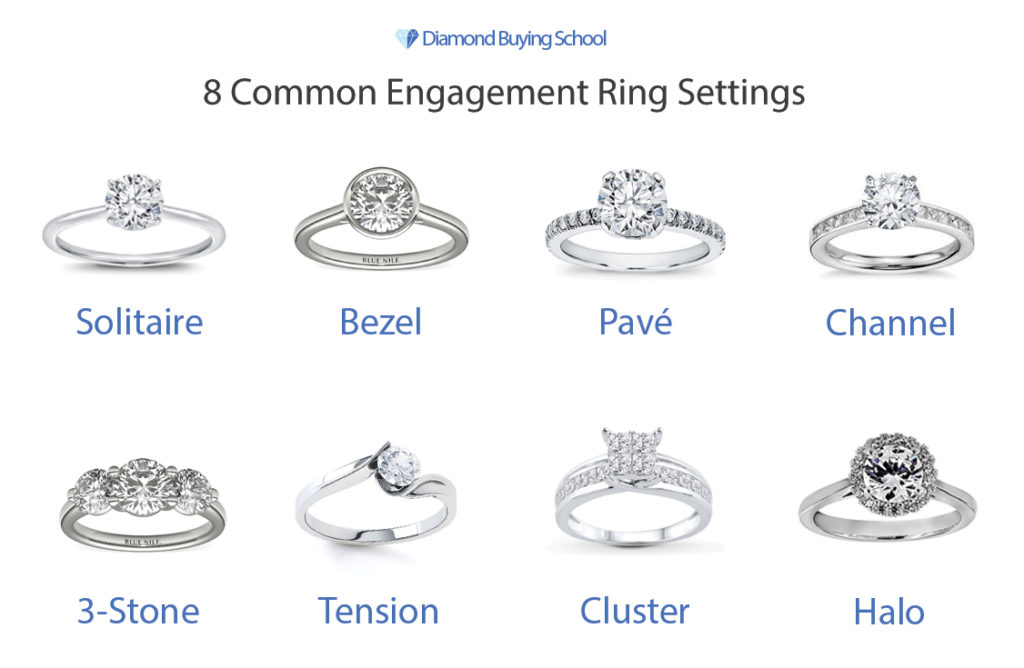
Taste and style are a big part of choosing a ring setting. But there are objective differences between settings you will want to consider. Each design has advantages. Some designs have surprising disadvantages, too.
Which engagement ring setting is best for you?
Solitaire settings
The diamond solitaire engagement ring setting is a simple, clean ring with one large diamond held by four prongs. Solitaire rings are the most popular choice for couples.
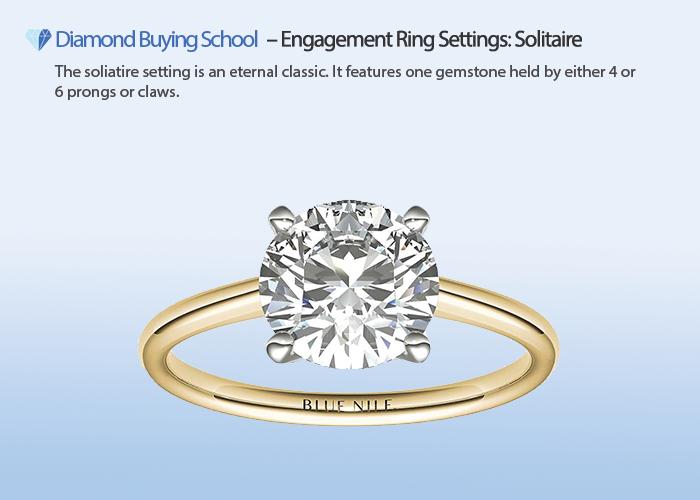
A solitaire engagement ring is the definition of classic. It’s never trendy. It’s been around since diamond engagement rings became a tradition over 100 years ago. And will be here in 100 more years.
The solitaire setting clearly showcases the diamond. And the diamond is the central symbol of the engagement promise: that love is forever.
The best diamond cut (shape) for a diamond solitaire is a round brilliant cut. It’s the classic diamond cut. It’s as minimalist and yet stunning as the solitaire setting itself. A round-cut diamond also showcases the diamond’s fire and brilliance better than any other shape.
That said, any beautiful diamond can be elegantly displayed in a simple 4-prong solitaire setting. Princess- and emerald-cut diamonds are also excellent choices in a solitaire ring.
Two famed variations on the solitaire include the cathedral solitaire and the prong solitaire.
Prong/claw solitaire settings
Prong (or claw) settings are the most popular kind of solitaire rings. This class of solitaire setting includes 4-prong and 6-prong varieties.
The 4-prong solitaire setting allows the maximum amount of light to hit the diamond below the girdle (the middle ridge of a diamond, dividing the “top” from the “bottom”).
That’s important because the more light hitting below the girdle in a round brilliant and other brilliant cuts, the more light that pours out through the top.
Brilliant-cut diamonds such as the round-brilliant, the princess, and others, maximize brilliance by controlling the flow of light. These diamonds work by absorbing light from the “bottom” area of the diamond and channeling that light, via precise reflecting geometries, through the top of the diamond. That’s the technical description of brilliance, or sparkle.
The 6-prong solitaire setting is often known as a “Tiffany” setting, even though any company can use 6-prong settings.
The Tiffany Setting is a trademarked design of 6-prong setting. It’s the most classic, most iconic setting for diamonds in the world. (That doesn’t mean it’s necessarily “the best.” It does mean it’s among the best.)
If you don’t mind paying the higher price for the Tiffany name, and the trademarked design, the Tiffany setting is a beautiful choice. Keep in mind, however, that you will pay a huge markup — somewhere between 50 and 80 percent — to buy a ring from Tiffanny & Co. The rings are nice, but it’s the little blue box that costs so much.
6-prong vs 4-prong solitaire ring settings
To my eyes, many 6-prong solitaire settings are as good, and even better, than a Tiffany setting. The Tiffany setting seems a bit chunky to me, compared to some of the thinner designs — especially when compared to 4-prong solitaire settings.
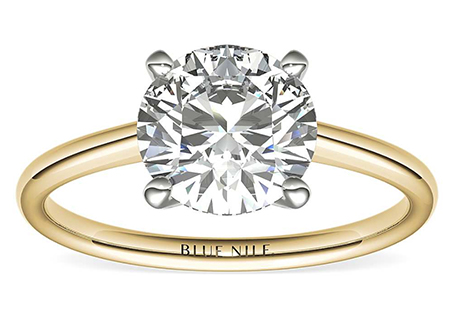
A 4-prong solitaire setting from Blue Nile. 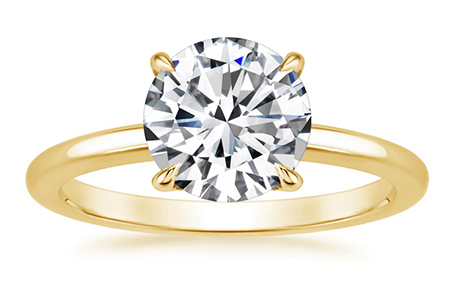
A 4-prong solitaire setting from Brilliant Earth. 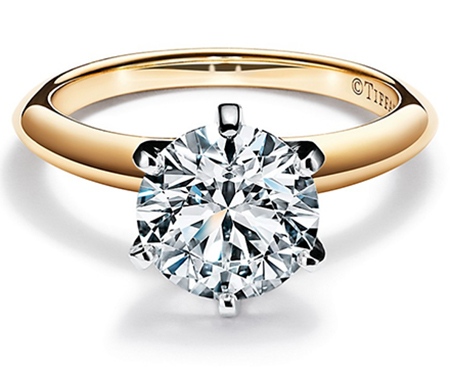
The famous Tiffany setting from Tiffany & Co. 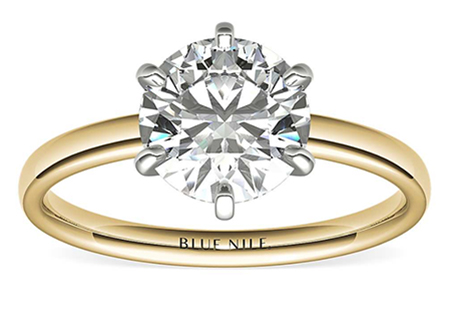
A 6-prong solitaire setting from Blue Nile.
The theoretical advantage of a 6-prong setting over a 4-prong setting is that a 6-prong setting has more security. The thinking is that six prongs are better than four for keeping a stone securely mounted. In reality, a properly maintained 4-prong solitaire setting is very secure.
The theoretical disadvantage the 6-prong blocks more light from reaching the diamond. Precise tests with light-measuring equipment would find that more light was blocked by the two additional prongs. It’s only logical. But it’s virtually impossible to tell the difference in light performance between a 4-prong and a 6-prong by simply looking.
So whether you prefer 4-prong or 6-prong really comes down to personal taste. Personally, I prefer 4-prong because:
- I know it’s plenty secure when maintained yearly
- I know the light performance is better, even if imperceptibly
- Most important, and this is a big, easily observable difference — there are fewer prongs blocking my view of the diamond
- Because the prongs are made of gold or platinum, there’s a small but real cost savings of having two fewer prongs.
All that said, I would consider a 6-prong setting for larger diamonds (2 carat and above).
Cathedral solitaire settings
The cathedral setting is a solitaire setting in which the prongs are“braced” by two arms flowing up along both shanks of the ring. It adds a subtle touch of modern flair to the classic solitaire design.
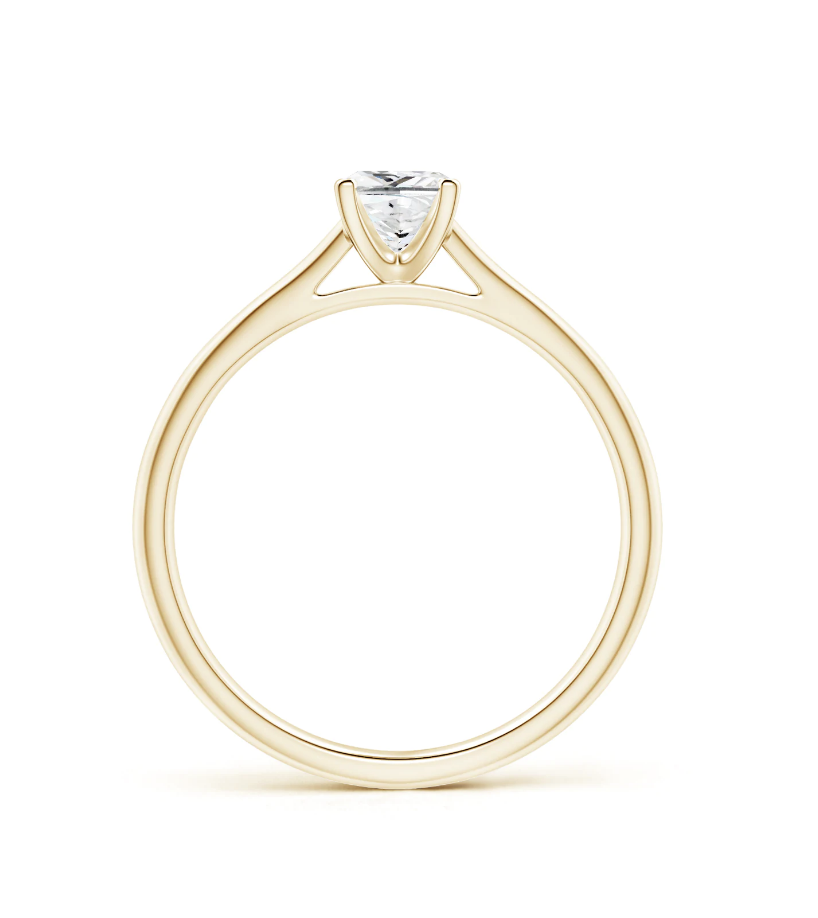
A cathedral solitaire setting in 14kt yellow gold. 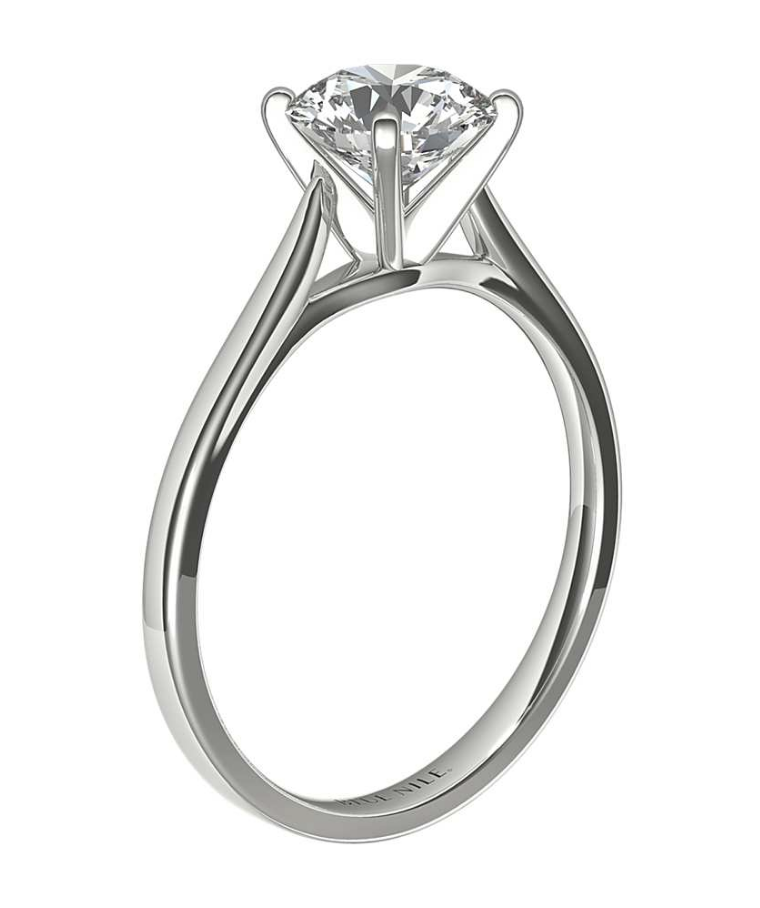
A cathedral solitaire setting in 14kt white gold.
Bezel settings
Bezel settings, sometimes called rub-over settings, feature a ring of metal (the bezel) that surrounds the gemstone.
Bezel engagement ring settings are modern and distinctive. But you should be aware of their disadvantages before you choose a bezel setting.
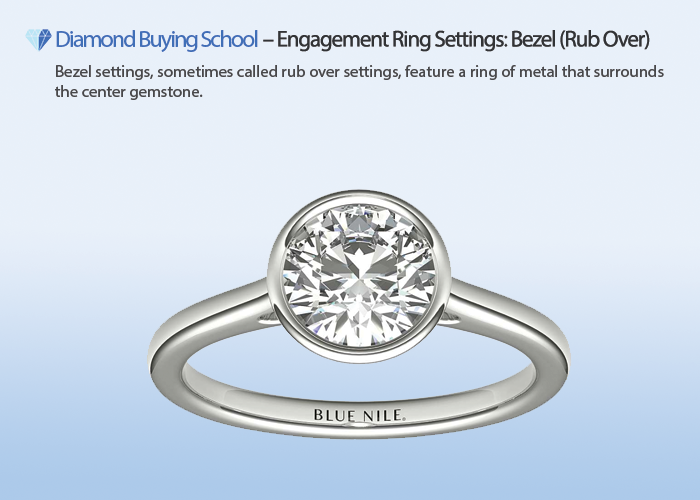
- They block some light from entering through the sides of the diamond.
- They block a significant amount of the view of a diamond.
A diamond exists to be seen. But a bezel hides so much of the diamond. Putting an expensive diamond in a bezel setting is like getting into the best shape of your life and then wearing baggy clothing!
On the other hand, a bezel-set engagement ring is distinctive while maintaining an air of classic simplicity. You might call it a modern classic.
One potential advantage of a bezel setting is that you could theoretically save a lot of money by choosing a diamond with an inclusion (flaw) that will be hidden by a bezel.
Pavé settings
A Pavé setting is a solitaire setting with accent diamonds mounted along the shanks of the ring. Pavé rings are popular and elegant. The setting maximizes sparkle from any direction.
Pavé is from the French word for “paved.” The shanks of the settings are paved with diamonds. Each one is on road leading to the center diamond.
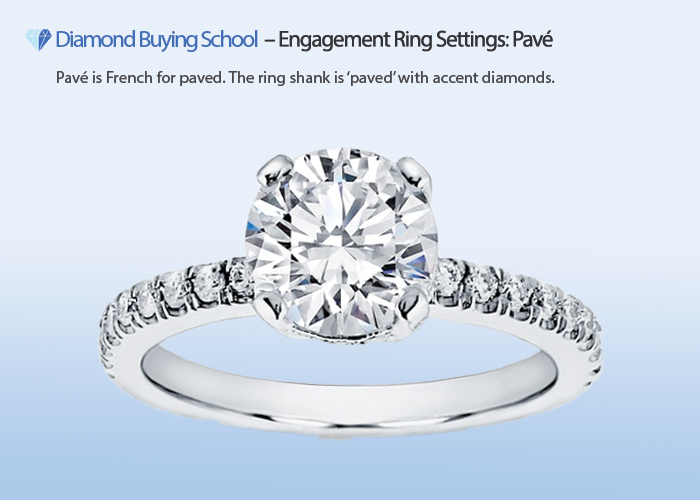
The accent stones are not hidden in a pavé setting as they are in a channel setting (below). Because of this, many people consider Pavé the natural way to use accent diamonds in what would otherwise be a solitaire setting.
In a pavé setting, every diamond — the center diamond and the accent diamonds — are maximally showcased. They’re not hidden at all by a bezel or channel. They’re not mounted right up against each other as in a halo setting or cluster setting, either.
Channel settings
A channel engagement ring setting features many small diamonds on the ring shank like a pavé setting, but here the accent diamonds on the shanks are enclosed along the sides in a channel.
They way the accent diamonds are set in a channel setting thickens the ring, making it more substantial. Some people say it’s more comfortable. The channels offer some protection for fingers from rubbing up against diamonds.
The diamonds in a channel setting won’t sparkle as much as they do in a pavé setting, because the channel prevents light from hitting the sides of the accent diamonds.
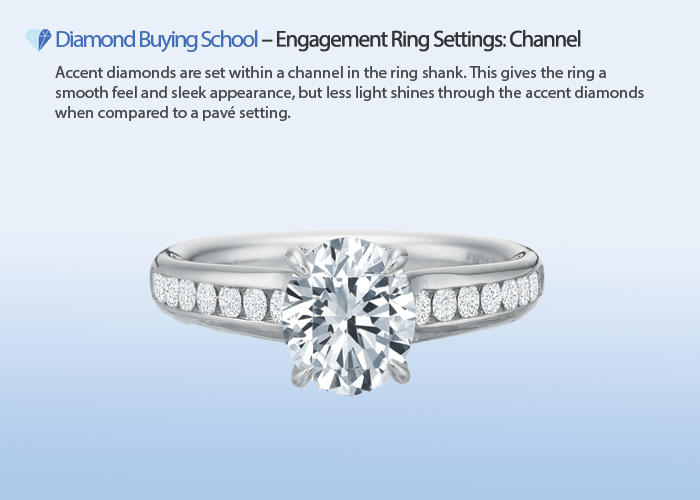
Split-shank settings
The split-shank engagement ring setting is a setting with shanks that split to encompass the center diamond.
They can be in the halo style:
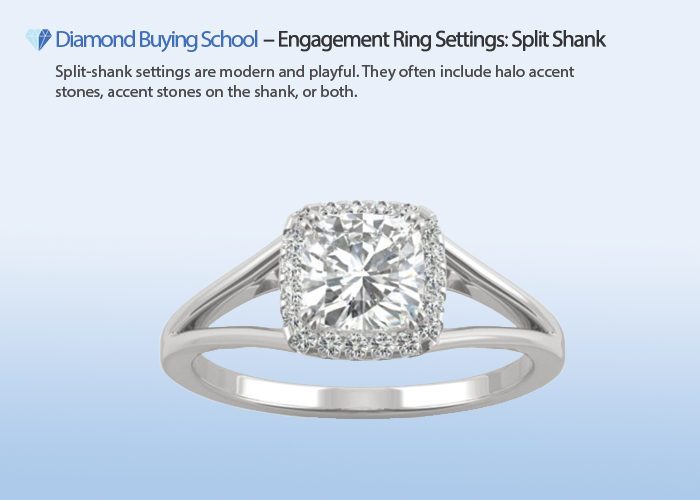
Or they can be in the pavé style with two rows of accent diamonds along each shank. And as the shanks approach the center diamond, the two rows part, so that they appear to flow around and under the center diamond.
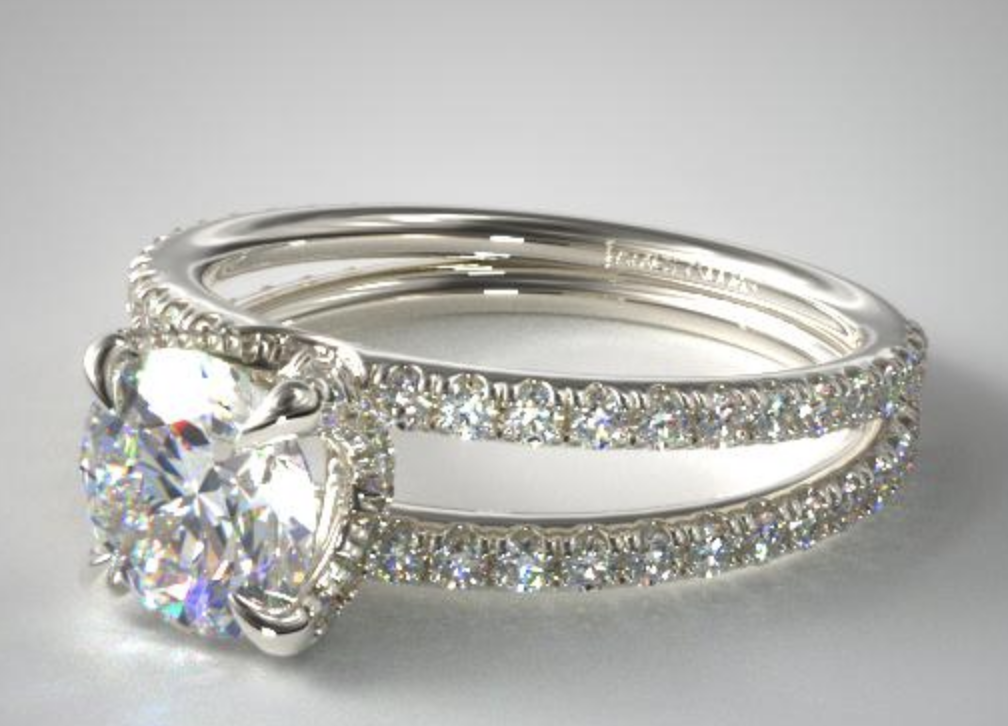
Or the split-shank may combine both a halo and pavé accent diamonds. The key characteristic is, of course, the split shank on either side of the diamond.
Split-shank settings bring some innovation and elegance. And when combined a pavé and/or halo style, they increase the bling factor of a ring by a great deal.
Halo settings
Halo settings encircle a center diamond with a solid ring of accent diamonds. They’re mounted so closely that it’s sometimes hard to tell where the center diamond ends and the halo of accent diamonds begin.
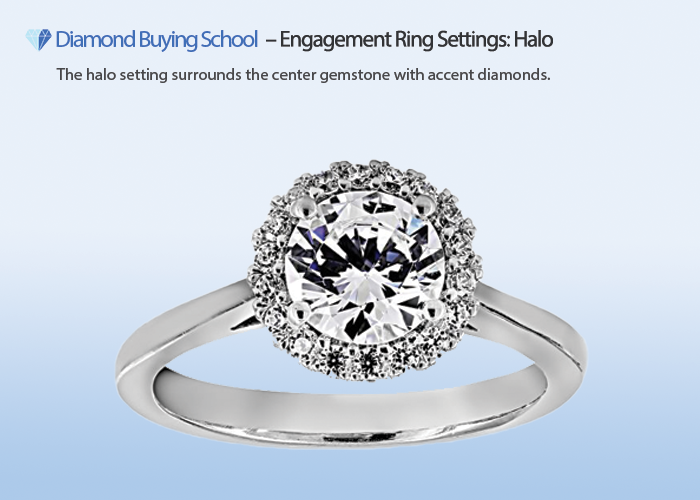
Halo rings are the best setting to make a center stone look a little larger, and possibly to increase the sparkle with a minimum of expense.
(Diamonds increase rapidly with small increases in size. So using a relatively smaller center stone together with a halo of color-matched accent diamonds is a cost-friendly way to increase apparent size.)
When buying a halo-set engagement ring, it’s important to pay attention to the quality of the accent diamonds in relation to the center diamond.
If one or more accent diamonds are of substantially different color or clarity than the center diamond, it will draw attention to the lowest-quality gem on the ring.
Color matching halo settings
Because of this, I recommend taking care in buying a halo setting. Buyers will especially want to be sure that the colors of the accent diamonds are closely matched with the color of the center diamond.
The halo accent diamonds should have the same color grade as the center diamond OR one grade lower. They should never have a slightly higher grade. That would make the center diamond appear slightly yellow by contrast.
For example, if the center diamond has a certified color grade of H, then the accent diamonds in the halo should have a color grade of H or I.
Clarity matching halo settings
The same is true of clarity grades for halo accent diamonds. The Clarity grades of accent diamonds should be matched, or should be one grade lower.
Tension settings
A recent trend, tension settings hold the diamond between two shanks by the tension of the metal alone.
Essentially, a tension setting ring is a rather elegant spring clip.
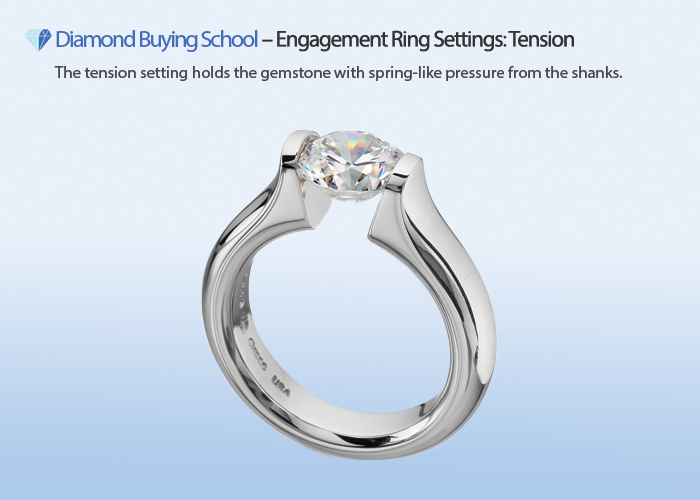
Tension settings are probably the best setting to spark comments and conversation. Just be aware, however, that no matter how admiring everyone will be on the surface, some people find tension settings too much of a stretch in style.
But if avant-garde innovation is your style, then this is an advantage. It expresses who you are.
What are the disadvantages to a tension engagement setting? They can appear bulky, depending on the design. They can block a lot of light, again depending on the design.
On the other hand the opposite can be true. Well-designed tension settings allow maximum light and maximum view of the diamond. In the best-designed tension settings, the diamond seems to float between the shanks by magic.
Three-stone settings
If any setting could hope to compete with the solitaire in timelessness and classic appeal, it would be the three-stone setting.
In a three-stone setting, a large center diamond is flanked by two medium-sized diamonds.
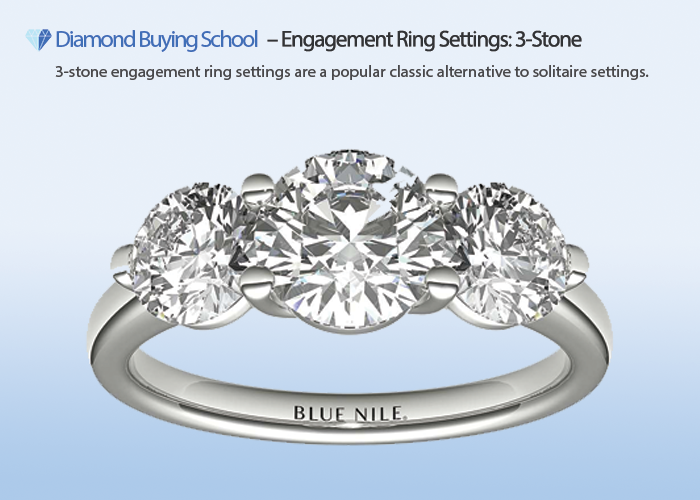
They can appear in all kinds of permutations: pavé, split-shank, and so on. But classically, they include just three stones.
Importantly, the two flanking stones should follow the golden rule of all accent diamonds: Don’t outshine the center stone, and don’t drag it down by poor quality.
So, as discussed elsewhere on this page, in color and clarity they should match the center stone or have grades of just one below the cetner diamond..
For example, if the center stone is of F Color, then the flanking stones should both be of F Color or H Color.
If the center stone is of VS1 clarity, then the flanking stones should be of VS1 or VS2 clarity.
Cluster settings
A cluster setting is typically a halo or pavé style, with one important exception: the center’s place is occupied not by a single stone, but rather by a cluster of accent stones.
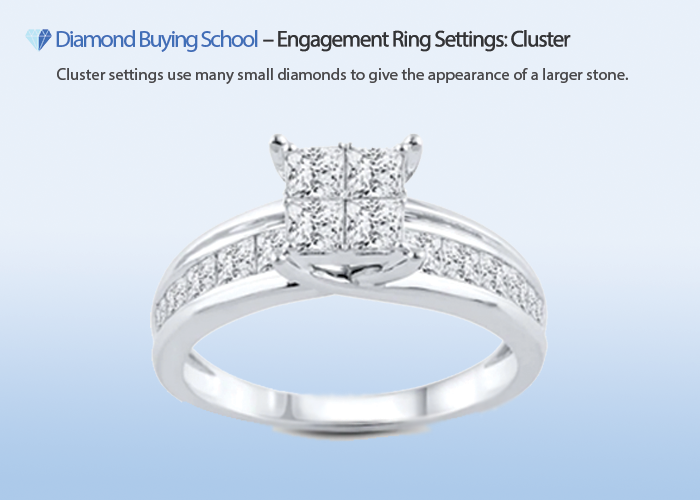
A cluster setting is one of the best settings for people who want to maximize apparent size while minimizing cost.
The cluster setting’s only real advantage is its apparent size.
But the major disadvantage is it has significantly less sparkle and fire.
Diamonds in a cluster setting can indeed create a large field of sparkle. However, side by side with a single diamond in a solitaire setting, the cluster won’t sparkle brighter or with more fire. In fact, a cluster setting will sparkle quite a bit less than a smaller solitaire.
Here’s why: The single diamond in a solitaire is open on all sides to the light. So it is collecting light from all sides and pouring it out of the top.
By contrast, the diamonds in a cluster are not all open to the light on the sides. All except those on the outer edge are blocked from receiving light from their sides.
I want to emphasize: Only the outer-edge diamonds in a cluster receive light from their sides. (Light does not flow sideways through two different stones very well. Diamonds are almost all designed to take light in from the sides and transfer it to flow out through the top. Thus the sparkle.)
As discussed earlier on this page, diamonds sparkle by taking light in from the sizes and bottom, and making it flow out through the top. So when any diamond’s sides do not receive direct light, the amount of actual brilliance will decrease, no matter how well it might perform by itself, freed from the cluster.
This means that despite what many people think when they see “all those diamonds” in a cluster setting, a single diamond in a solitaire setting will virtually always outperform all the diamonds in a cluster.
Which engagement ring setting is best?
In the end, the best engagement ring setting is the one that you and your fiancée love the most. As you shop among the different kinds of settings, you’ll settle on one specific style that you love.
I think it’s especially important to be aware of disadvantages of certain settings, since salespeople will rarely, if ever, point those out. They’re not necessarily trying to hide anything. They simply are polite and helpful. Being negative as a salesperson is never polite. So they might not point out that a cluster setting’s diamonds don’t sparkle as much as a single diamond in a solitaire setting.
For most people, the best settings for an engagement ring are the solitaire, the three-stone, or the pavé.
They’re not clichés. They are classics. They have solid light performance and unimpeachable aesthetics. They showcase the diamond.
So if you’re unsure where to start, start with those three.
The other settings among this “best of” list are all solid choices, as long as you know the factors involved in choosing each.
Recommended Jewelers
James Allen
James Allen is the most competitive diamond vendor with more than 150,000 loose diamonds in inventory. They have been a leader in selling diamonds online and pioneered 3D imaging so you can see the exact diamond you're buying in exquisite detail. You'll find it hard to beat James Allen in terms of price or selection. Read our James Allen review. |
Whiteflash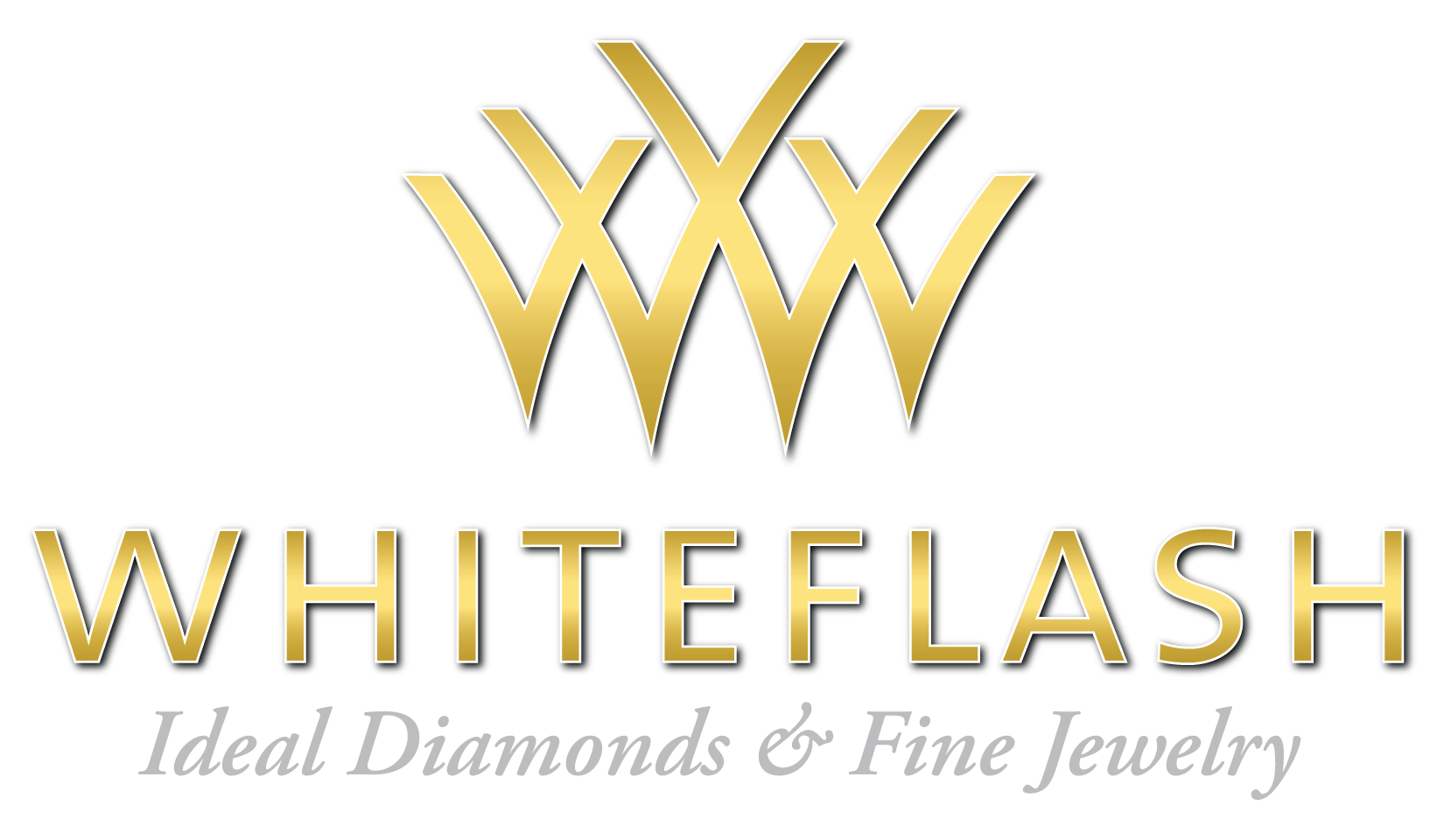
Whiteflash is the home of "A Cut Above" diamonds which are among the best quality round- and princess-cut diamonds in the world. With superior diamond photographs and videos, Whiteflash's diamonds seem to come to life -- even online. Read our Whiteflash review. Shop Whiteflash » |
Brilliant Earth
Brilliant Earth is the global leader in ethically-sourced jewelry. Brilliant Earth goes above and beyond existing standards to offer “Beyond Conflict Free Diamonds” that they select for their ethical and environmentally-responsible origins. With over 120,000 diamonds in inventory, you can be sure to find your perfect diamond and feel good knowing it was responsibly-sourced. Read our Brilliant Earth review. Shop Brilliant Earth » |
Blue Nile
Blue Nile is the world's largest online jeweler. Their reputation for quality and customer service is unparalleled in the industry. Blue Nile offers free shipping, a 30-day return policy and satisfaction guarantee. Read our Blue Nile review. Shop Blue Nile » |